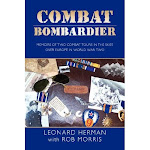
Bob Cozens with his crew, top row, second from right.

The Patsy Ann, Bob's B-17 named after Pat.

Nose art of Patsy Ann.
I got back from Oregon last night, and today had my scheduled and long-anticipated phone interview with Robert 'Bob' and Patsy Ann 'Pat' Cozens. Seems like I've known Bob forever, but actually, I first got in touch with him about seven or eight years ago when I was researching 'Untold Valor'. Bob and Pat are an incredible couple, and I wanted to talk to them both about what it was like to be a married couple during the war years. Bob is still a strikingly handsome man, and Pat remains as beautiful as ever. They recently celebrated their 65th Wedding Anniversary. Pat has been very helpful in filling in a fairly unknown aspect of the air war--what did the wives do while their husbands were off fighting--and dying--in the skies over Europe, and how did they cope with the constant stress and fear?
For the complete story, please wait for my 95th Bomb Group unit history, co-authored by Ian Hawkins and due out next year. But here are some highlights of this wonderful interview with two amazing people.
Bob and Pat met before Bob went into the Air Corps. Cadets were not allowed to get married, so they waited until Bob was sworn in as a pilot. He is fond of saying that 'the Air Corps gave me my wings in the morning, and the little lady clipped them in the afternoon'. Thus began a lifetime together.
Pat followed Bob to many of his early training postings, including Spokane, Washington and Rapid City, South Dakota, and it wasn't easy. While Bob was stationed in Spokane, Pat shared a motel room with two other wives. The husbands were restricted to base six days a week, but got one day off. Whichever husband was off on a particular night, that husband and wife got the bedroom in the shared unit.
Pat remembers that "I was 22 at the time, but looked about 12, and was very shy." After the 95th's Commanding Officer, Colonel Alfred Kessler, suggested to the men that they not take their wives to their next training post at Rapid City, Pat, who was not an experienced driver, had to drive their car from Spokane all the way to California on her own. They spent their first married Christmas apart, and Bob remembers "it wasn't the happiest of Yules". However, once in Rapid City, Bob noted that there were ten or so other wives there, so he told Pat to "come on over".
"Pat spent more time on buses, or cars," remembers Bob. "I have great respect for her for that." Why did she do it? "True love," is her answer.
When Pat arrived in Rapid City, South Dakota in 1943, "it wasn't much of a town. It was cold and windy. The Hotel Alex Johnson was an average hotel for that area. That's where I ended up staying. I was very shy," and though she knew some of the other wives casually, she only made friends with a few. Her best friend was a young lady named Jerry Stirwalt, whose husband Harry was the flight leader in the 334th Squadron. Jerry had with her their 9-month-0ld son.
"Around midnight one night," remembers Bob, "We were advised that we were going overseas, and by two o'clock a bunch of us had piled into a car and were on our way to California to drop off our wives and see our families. We drove 36 hours to California--straight through."
By this time, Pat was six months pregnant with the couple's first child. This must have been a rough trip to take under those conditions.
From there, remembers Bob, they went up to meet his father-in-law for the first time. He chuckles when he remembers dropping the six-month-pregnant Pat with her parents. "All I had time to say was 'Hi, Dad. Glad to meet you. Take good care of my wife--I'm going to fight the war," remembers Bob. Then, the young couple was seperated.
"The day I got to England with my crew," remembers Bob, " was the same day my first son was born. It was April 17, 1943. I didn't know about it for two or three weeks. Pat had to call a taxi to take her to the hospital to get delivered."
As Bob flew dangerous early missions over Europe, Pat waited for him back home. When asked why their relationship survived the war when so many others did not, she responds, "True love. He was the one for me. I wasn't interested in anyone else." Bob, too, stayed faithful to his wife, avoiding the pitfalls of many of his colleagues. "I never went into Horham," he remembers. "And when we went to London, my main stop was to get to Dunhill's Pipe Shop as early in the morning as possible, to be there when it opened. I was a pipe smoker."
Pat sent Bob an 8-millimeter film of their new baby, but Bob couldn't find an 8-mm projector anywhere on the base. Desperate, he went to the 95th's Photo Section and watched it one frame at a time.
The third mission flown by the 95th--to Kiel--nearly wiped out the entire unit. Pat's best friend in Rapid City, Jerry Stirwalt lost her husband Harry on this mission, leaving her alone with a young child. Pat never knew how bad the missions were until that one. Of all the men in Bob's squadron who went over from the States, only three officers completed their 25 missions without being killed, wounded or shot down.
"I worried about it every day and every night," she remembers. "I just tried to keep busy, to keep positive, and I did a lot of praying. I was happy I had a child because if Bob were lost, at least I'd have a little piece of him."
Her fears were not unfounded. Two of Bob's brothers, also Air Corps pilots, were killed in training in the States.
Bob Cozens did survive his tour of 25 missions, one of the very lucky few--known as the "Lucky Bastards". On December 22, 1943 he sent Pat a telegram. "I have just completed my 25th mission". It was over. He had survived. He could come home to his new family.
Over sixty years later, Bob and Pat grace the 95th Reunions. Bob is a quiet leader, a modest but excellent speaker, and a man loved and admired by all. And Pat continues to be the prettiest woman in the room.
This story copyright 2008 by Rob Morris. All rights reserved.












 When I drove away, I took this photo of the farmstead and windbreaks from the outside.
When I drove away, I took this photo of the farmstead and windbreaks from the outside. Grandson Eric 'Erky' Davis was a ring-bearer. He sure looked spiffy in his green tie that was almost as tall as he is.
Grandson Eric 'Erky' Davis was a ring-bearer. He sure looked spiffy in his green tie that was almost as tall as he is.










 Medicine Bow today. Left, the Virginian Hotel, at one time the tallest building between Denver and the coast. Right, the old train station, now a museum.
Medicine Bow today. Left, the Virginian Hotel, at one time the tallest building between Denver and the coast. Right, the old train station, now a museum.


























